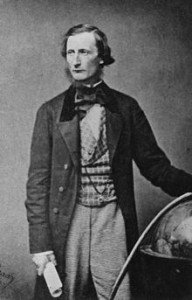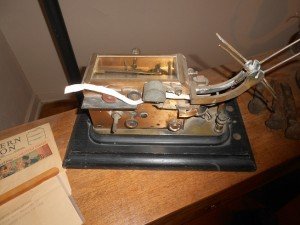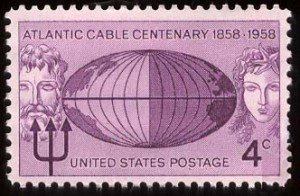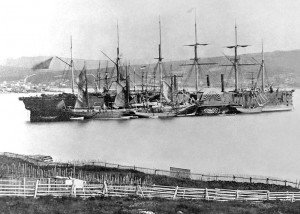There are several very interesting historic sites which commemorate what was arguably the most ambitious and world changing project of the mid 1800’s. By the same token, this daunting project is one of the most under publicized feats of the entire nineteenth century.
Thank you for reading this post, don't forget to subscribe!
Must See Trans-Atlantic Cable Museums
A visit to the Hearts Content Cable Station at the town of Hearts Content Newfoundland has all the information and exhibits you need to fully understand the significance of the first submarine transportation cable laid across the Atlantic Ocean. This was the cable that was responsible for the joining of the New World with the Old World. The town of Hearts Content, at the time a small fishing village, became the western terminus of the first trans-Atlantic telegraph cable.
The Porthcurno Telegraph Museum is located in the small coastal village of Porthcurno Cornwall, United Kingdom. It was at this location that many of the trans-Atlantic cables came onshore on the eastern side of the Atlantic. Among the exhibits found at the Portcurno Telegraph Museum are displays showing the history of submarine cable laying ships and telegraphy. You’ll also see a variety of cable designs. You’ll be amazed at the engineering involved during the mid 1800’s in not only designing an undersea cable that could carry an electric pulse over thousands of miles but also the designs of cable laying equipment that made the entire project possible.

A Determined Man
By the mid 1850’s telegraph lines stretched across much of the United States and England. This certainly allowed people in those countries to quickly communicate with one another. The questions was…how can these same people communicate quickly between countries.? The fact was they couldn’t. The only option was through the mails via ocean vessels and this certainly was not quick communications.
There were many people responsible for the success of the first undersea telegraph cable and the names are too numerous to detail in one article. The name of Cyrus Field however stands out from the rest. For those really desiring to explore this fascinating story and the story of Cyrus Field further, one very good book is A Thread Across the Ocean by author John Steele Gordon.
It was Cyrus Field who, beginning in 1854, began work to sell his idea and obtain the enormous financing required. It was also Cyrus Field who persevered with the project after several costly cable laying failures and when others suggested abandoning the effort altogether.
More Than One Attempt
If there’s one thing that can be noted about the laying of the first telegraph cable across the Atlantic Ocean, it’s that there were several attempts. The initial failures of course made it even harder to obtain further financing. During the year prior to the successful completion, another failure occurred when the cable snapped and fell to the ocean floor. Interestingly enough, grappling equipment was used to snare the broken cable and bring it up for repair. Sometimes this worked, other times it didn’t and often it took quite a while to complete.
After the successful attempt in 1866, the ships went back to the area of the 1865 failure and did indeed pull up the broken cable, made the necessary repairs and in so doing completed the second transAtlantic telegraph cable. Now two Atlantic cables could theoretically carry twice as much traffic.

To Solve Everything That Could Go Wrong
If you think laying an undersea telegraph cable off the back of a ship was relatively easy…think again. Of all the tasks involved in doing this job successfully, probably the most important was to prevent the Trans Atlantic cables from snapping due to strain. When a ship bobs in the ocean while extending a cable off it’s aft end the chances of it’s snapping from the sudden increase in pull pressure was quite real. Engineering had to solve this problem and they did.
There were a few different pieces of equipment that were designed to let out cable from behind an ocean vessel. The most successful apparatus was designed by chief engineer William Everett in London. Everett’s “paying-out machine” as it was called was designed with brakes that some would say acted as if it were human. The brakes could be set with maximum pressure and they would automatically release if the pressure exceeded that limit. Everett’s design kept the cable from snapping and being lost to the bottom of the sea. To give you an idea of just how successful William Everett’s paying-out machine was, cable laying ships to this day still use much of his original design.

How about the cable itself? When you consider just how long the trans-Atlantic cable was, you can appreciate the work done to actually make it work. Remember, this was mid 1800’s technology and unlike the cross country telegraph system in the United States, the electrical pulse had to be carried within a cable strung along the ocean’s floor. The cable that was developed for the successful attempt in 1866 was manufactured at a rate of twenty miles per day. This cable had galvanized iron armoring that was rustproof and the wires were coated with a zinc-iron alloy which allowed the cable to take a half ton more strain before snapping. Amazingly, all of this 1800’s technology was developed at a time when America itself was going through a Civil War.

The Historic Ship Great Eastern
The “Great Eastern“, was first a passenger ship and in addition to that was the largest man made vessel afloat during the 1860’s. Because of her enormous size, the ship was ideal for laying a telegraph cable clear across the Atlantic Ocean. It was also the vessel that used the paying-out equipment developed by William Everett.
It was the Great Eastern that had the distinction of being the first vessel to successfully lay the trans-Atlantic telegraph cable in 1866. It was the ship, along with her escort vessels, that steamed into Hearts Content Newfoundland on July 28, 1866.
Links to three additional Trips Into History articles you’ll find interesting is the story of Marconi’s Trans-Atlantic Wireless Success … Building of America’s Transcontinental Telegraph and a Visit to the Historic Paul Revere House in Boston MA

Learn More About This Amazing 1800’s Accomplishment
The history of the 1800’s is filled with various wars both in North America and in Europe. The American westward migration beginning in the 1840’s onward was another significant event. The successful laying of the trans-Atlantic telegraph cable may indeed have eclipsed all other events in regards to the impact it had on people from both sides of the ocean. The very fact that messages could be transmitted in a matter of minutes as opposed to the time it took a ship to cross the ocean changed many lives.
The commercial impact where commodity prices alone could be merged in both the London and New York markets might be called the start of globalization. From 1866 onward, these telegraph cables would go on to connect nearly all parts of the world. This 1866 event had the effect of making the world a smaller place. Soon wireless telegraphy would emerge as well as telephony. Today we have the internet. The laying of the trans-Atlantic telegraph cable and the drive and imagination of Cyrus Field to make it a reality ushered in an entirely new era that continues to be improved upon to this day.
As mentioned earlier in this story, the museums in both Hearts Content Newfoundland and the one located in the small coastal village of Porthcurno Cornwall, United Kingdom are great places to start. If you have the opportunity to be near either location I’m confident you’ll be fascinated.
Yet another interesting site to visit is Valentia Island Ireland which was the eastern terminus of the first Atlantic cable. Valentia Island made it the ideal spot for the first cable to land in the United Kingdom. Today some of the buildings of the old Valentia Cable Station can still be viewed from the outside along the main street of Knightstown. You’ll also see a plaque commemorating the event. Original items from the cable station are on exhibit at the Valentia Heritage Centre. Valentia Island is located just off the coast of County Kerry, Ireland.
More interesting information on the Trans Atlantic cable story can be found in the book mentioned earlier, A Thread Across the Ocean by author John Steele Gordon and also in The First TransAtlantic Cable by author Adele Gutman Nathan.
(Telegraph ticker tape photo from author’s collection. Remaining photos and images from the public domain)
